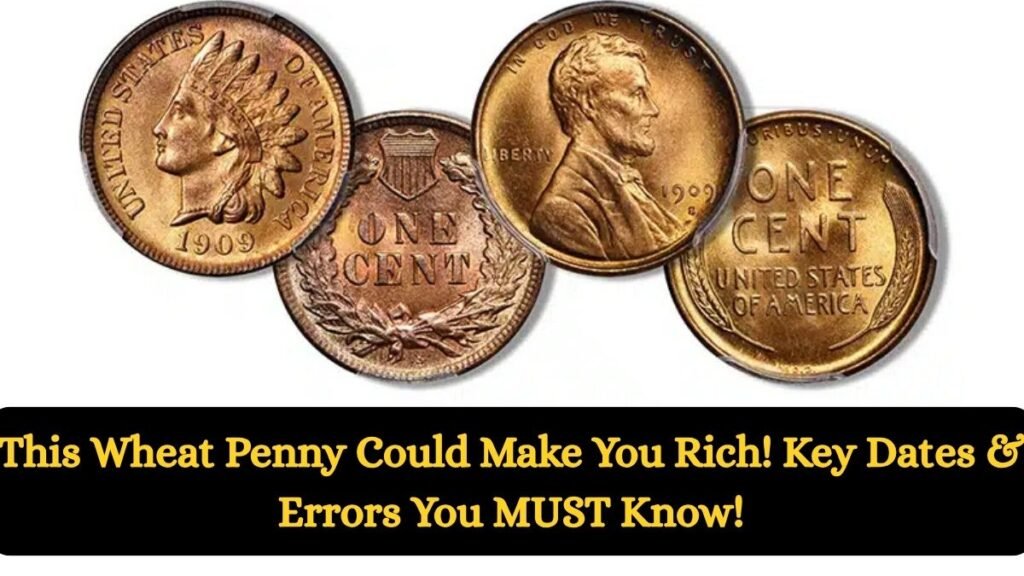That Heart-Pounding Moment Every Collector Lives For
I’ll never forget the summer afternoon I spent sifting through my grandfather’s dusty coin jars. My fingers froze when I spotted a 1909-S Lincoln cent—was this the legendary VDB? Turns out it was “only” the 1909-S (no VDB), but that rush of adrenaline captures why Wheat Pennies (1909–1958) remain America’s most collected coin.
These humble cents are democratic treasures: affordable for beginners yet hiding rarities worth life-changing money.
Let me walk you through the Wheat Penny Key Dates and Errors that could be lurking in your own change jar.
Related How Many Dimes Make a Dollar? Click to find out!
The Reality Check: Most Wheat Pennies Aren’t Retirement Funds
Before we dive into the jackpots, let’s ground expectations. 90% of Wheat Pennies found in circulation are worth 3–10 cents each. After sorting thousands of bank rolls, here’s what I’ve learned:
- Post-1933 common dates (especially Philadelphia issues) rarely exceed 10¢ in worn condition.
- 1943 steel pennies (zinc-coated wartime coins) are common—worth 5–10¢ unless pristine
- Condition is king. A 1914-D in “Good” grade might fetch $200, but that same coin worn flat? Maybe $25
*Pro Tip: If your penny is post-1933, has no mintmark (“P”), and no obvious errors, enjoy it as history—not a windfall.*
Related How Many Nickels Make a Dollar? You’ll Be Shocked by the Answer!
The “Big Four” Key Dates: Coins That Make Collections
These four pennies are the holy grails. Finding one in circulation today is like winning the lottery, but they do surface in inherited collections.
1. 1909-S VDB: The Scandalous Rarity
- Why valuable: Designer Victor Brenner’s “VDB” initials were removed mid-1909 after public outcry over “illegal advertising.” Only 484,000 escaped the Mint.
- Value: $700 (worn) to $150,000 (MS67 Red).
- Personal insight: A collector I met found one in a $10 bank bag—proof miracles happen!
- Watch for: Counterfeits adding “S” mintmarks to 1909 Philadelphia coins. Always buy certified.
2. 1914-D: The Denver Ghost
- Why valuable: Scarcest Denver issue (1.2 million minted). Most were heavily circulated, with low survival rates.
- Value: $150 (VG grade) to $55,000 (MS65).
- Key identifier: Weak “D” mintmark under Lincoln’s shoulder.
3. 1922 “No D”: The Vanishing Mintmark
- Why valuable: Denver accidentally produced pennies without the “D” mintmark due to die polishing or grease clogs. Three varieties exist:
- Strong Reverse (rarest, up to $25,000)
- Weak Reverse ($1,000–$5,000)
- Weak “D” ($35–$1,000)
- Red flag: Fraudsters often remove the “D” from 1922-D cents. Authentication is critical.
4. 1931-S: The Depression-Era Secret
- Why valuable: Only 866,000 minted as penny demand cratered. Savvy collectors hoarded them early.
- Value: $60 (circulated) to $18,600 (MS66 Red).
Semi-Key Dates: The “Affordable Rarities”
These aren’t million-dollar coins, but they’re the backbone of serious collections. I built my first set hunting these:
| Date & Mint | Why Valuable | Avg. Value (VG–Unc) |
|---|---|---|
| 1910-S | Low mintage (6M) | $8–$120 |
| 1911-S | Scarce San Francisco issue | $20–$230 |
| 1924-D | Denver rarity (2.5M) | $16–$400 |
| 1926-S | Tough San Francisco find | $1.70–$270 |
*True story: My 1912-S (worth $300) came from a flea market bin labeled “junk pennies”—never underestimate clueless dealers!*
Error Coins: When Mistakes Make Millionaires
Error coins are my passion—they’re unpredictable and often missed by newbies. These are the crown jewels:
🧲 1943 Bronze Cent: The Copper Mirage
- The error: Struck on leftover copper planchets during WWII steel penny production.
- Value: $100,000 (circulated) to $1.7M (MS64).
- Authenticity test: Use a magnet! Bronze coins won’t stick; steel ones do.
🔍 1955 Doubled Die Obverse: The Naked-Eye Wonder
- The error: Misaligned die caused dramatic doubling on the date and “LIBERTY.” 20,000–24,000 exist.
- Value: $1,000 (worn) to $288,000 (MS65+)
- Origin story: Many entered circulation via cigarette vending machines in Massachusetts that gave two cents as change.
⚙️ 1944 Steel Cent: The Chronology Mix-Up
- The error: Struck on leftover steel planchets post-WWII when copper returned.
- Value: $75,000 (circulated) to $150,000 (uncirculated)
🔄 Repunched Mintmarks (RPMs): The Hidden Clues
- Examples: 1909-S Over Horizontal S, 1944-D D Over S.
- Why valuable: Mint workers corrected mispunched mintmarks, leaving ghostly traces.
- Value: $120 (circulated) to $5,875 (uncirculated).
How to Hunt Like a Pro: Practical Tips from a Lifelong Collector
- Sort chronologically: Focus on pre-1934 dates first—they’re exponentially scarcer.
- Invest in tools: A 10x loupe ($15) reveals RPMs and doubling. My 1909-S Over Horizontal S find netted $350
- Avoid cleaned coins: Soaking pennies in vinegar destroys surfaces and value.
- Hunt strategically:
- Estate sales: Look for “coin jars” priced by weight.
- Bank bags: My 1922 Weak D came from a Wells Fargo penny bag
- Vintage rolls: Unsearched rolls sometimes yield semi-keys.
“In every old jar of pennies, there’s hope. Maybe not retirement hope, but history-happening-in-your-hands hope.”
Why We Still Dig Through Cents
Wheat Pennies are time capsules: from the 1909 debut honoring Lincoln’s centennial to the 1943 steel cents supporting WWII efforts. They’re accessible history—coins you can start collecting with pocket change. And while most are worth pennies, that one-in-a-million find (a 1943 bronze or 1909-S VDB) keeps us searching. Grab a magnifier, check those dates, and remember: your treasure is out there.
For further research, explore PCGS or NGC population reports to verify rarity claims
